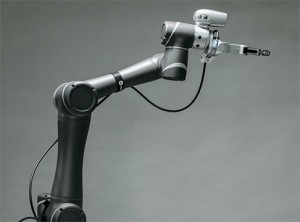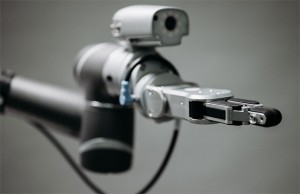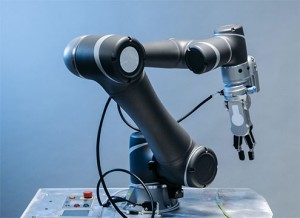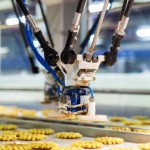IO-Link RFID helps improve cobot capabilities
 When an automotive manufacturer needed a low cost, easy-to-implement solution to add RFID verification to the automated tooling change system, for a small robot working as a machine tender to an expensive and delicate machining centre, it turned to Contrinex.
When an automotive manufacturer needed a low cost, easy-to-implement solution to add RFID verification to the automated tooling change system, for a small robot working as a machine tender to an expensive and delicate machining centre, it turned to Contrinex.
The integration of interchangeable end-of-arm tooling for robots increases their flexibility and capability but also adds complexity. In some applications or industries, there can be a need to verify, plus perhaps track and record which tools have been used.
In an aerospace application, for example, recording which end tools were used, might be required for the traceability of the process. In an automotive factory, tracking of the tooling might be used to ensure that it receives visual inspections and refurbishment after a set number of uses.
In the automotive application, tracking of the tooling might also be used to quantify and adjust the time intervals of inspection and refurbishment. It could provide precise usage data which can be analysed for insight into the wear performance of different processes or tooling suppliers.
At one particular automotive manufacturer, a small industrial robot was being used for machine tendering – loading and unloading a wide variety of components to a machining centre. The manufacturing cell is extremely flexible in the size and shape of components it can process and therefore the robot uses a variety of interchangeable end-of-arm tooling or end-effectors.
The machining centre is specialised and delicate and so to eliminate the risk of damage from the robot, its end-of-arm tooling or a misloaded component, a system is required that guarantees the correct end-of-arm tooling is fitted to the robot for each load or unload movement.
 A Contrinex IO-Link RFID read/write module is mounted beside the storage rack of interchangeable end-of-arm tooling. Before the robot disengages the end-effector, it presents it and the RFID transponder tag mounted to it, to the read/write module. Similarly, when a tool has been picked up and mounted by the robot, the transponder tag is presented to the RFID read/write module to verify that the correct tooling has been selected.
A Contrinex IO-Link RFID read/write module is mounted beside the storage rack of interchangeable end-of-arm tooling. Before the robot disengages the end-effector, it presents it and the RFID transponder tag mounted to it, to the read/write module. Similarly, when a tool has been picked up and mounted by the robot, the transponder tag is presented to the RFID read/write module to verify that the correct tooling has been selected.
The RFID transponder tag is an active component that can have data written to it like a USB stick, as opposed to a passive element like a barcode identification label. The tag can be thought of as being like an electronic job card, with operations recorded in its memory. In this application, in addition to its primary purpose of identifying and recording an end-effector’s use on the robot arm, the maintenance team, used the tag to record when the tooling is serviced and by which supplier. The maintenance team can query the transponder tag to see the tooling’s history, even when it is away from the manufacturing cell and its PLC.
The Contrinex read/write module chosen is unusual because rather than communicating over an advanced protocol like ProfiNet, it uses the low-cost IO-Link protocol, which the simple and low-cost PLC can directly communicate to. This removes the need to use an expensive protocol converter or a more expensive and advanced PLC than is required for this simple machine tendering application.
Contrinex has combined two of factory automation’s key communication standards into its IO-Link RFID read/write units to offer simple installation and integration. Contrinex’s ISO15693 RFID standard transponder tags and read/write modules are mechanically robust, being designed to cope with shocks, hot water, corrosive chemicals and high-pressure jetting, to provide ultra-high reliability.
The ConIdent passive transponders tags require no internal power source, so maintenance is minimised as there are no batteries to monitor and replace. It was also advantageous that the transponder does not need an electrical connection to the robot arm, which would have significantly increased complexity.
 The robot is only allowed to tend the machine when the machine controller is assured that the correct end-of-arm tool has been fitted and the correct parameters loaded. This guarantees fast tool changeover and avoids the risk of an impact between the machine and the robot tender.
The robot is only allowed to tend the machine when the machine controller is assured that the correct end-of-arm tool has been fitted and the correct parameters loaded. This guarantees fast tool changeover and avoids the risk of an impact between the machine and the robot tender.
An additional benefit of the system’s stability is that the maintenance team can precisely monitor the wear and performance of different tooling designs and suppliers to make improvements and cost savings.
Contrinex’s extensive RFID range also includes transponders designed to survive vibrations and shock, or high temperatures within harsh manufacturing environments, or transponders which can survive the aggressive cleaning chemicals of the food and beverage industry.
Contrinex also offers a unique, ‘metal-friendly’ system offering transponders encased in hermetically sealed, food-safe, stainless-steel housings, which can be embedded into metal tooling or stillages, for example.
Visit the Plus Automation website for more information
See all stories for Plus Automation
















